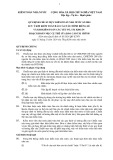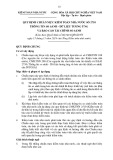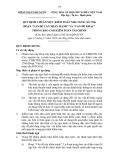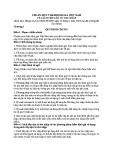
ECONOMICS - SOCIETY https://jst-haui.vn HaUI Journal of Science and Technology Vol. 60 - No. 11E (Nov 2024)
70
P
-
ISSN 1859
-
3585
E
-
ISSN 2615
-
961
9
EVALUATING FACTORS AFFECTING THE STABILITY OF VIETNAM'S FINANCIAL SYSTEM
Thi Thanh Hoang1,*, Thuy Duong Phan1 DOI: http://doi.org/10.57001/huih5804.2024.345 ABSTRACT The article evaluates factors affecting the
stability of the financial system
in Vietnam. Because of many unpredictable fluctuations, significantly
affecting trade and investment activities, financial stability is always an
essential requirement for Vietnam to ensure the healthy development of the
e
conomy. The data were collected from Vietnamese banks' financial reports
from 2006 -
2020, Word Bank, and the General Statistics Office of Vietnam.
Statistical description, matrix correlation, and regression are methods to
estimate factors affecting the fi
nancial system's stability in Vietnam. The
feasible generalized least squares regression method was used to analyze the
influence of the actors on the stability of the Vietnam's financial system. The
Current Account, inflation, Vietnam's economic growth an
d exchange rate are
internal variables affecting financial stability. Shocks on financial stability
impact the financial stability of internal factors with opposing movement
patterns. Inflation puts severe pressure on the stability of Vietnam's financial
s
ystem. Vietnam's economic growth, current account surplus, and exchange
rate contribute to stabilizing the financial system. Besides, the results of
empirical research explain the impact of shocks on the financial stability of
internal factors such as the
current account, exchange rate, inflation and
Vietnam's economic growth. The paper proposes recommendations to
stabilize the Vietnam's financial system based on the experimental results. Keywords: Finance, inflation, stability. 1University of Transport Technology, Vietnam *Email: thanhht@utt.edu.vn Received: 12/5/2024 Revised: 20/7/2024 Accepted: 28/11/2024 1. INTRODUCTION Financial stability is essential in stabilizing prices, supporting sustainable economic development, and minimizing negative impacts on the macroeconomic safety of the economy [26]. A stable financial system is a system with healthy operations, reliably and efficiently, with little volatility and the ability to absorb shocks. It reflects a healthy financial system, thereby creating confidence in the financial system while helping to prevent market chaos and minimize negative impacts on the macroeconomic safety of the economy. The fact in the world show that financial crises occur every decade. In the 19th and early 20th centuries, many financial crises were linked to banking panics and many related economic downturns. Therefore, building, identifying, and evaluating the influence of factors on the stability of financial system is necessary to monitor the financial system's stability and prevent financial crises from occurring and has always been a significant concern for many countries. Several basic principles must be followed to manage and monitor financial stability: integrating monetary fundamentals, incorporating micro and macro security supervision, having a framework for safety regulations, and international cooperation [5]. After economic reform in 1986, with a multi-sector economy and active integration into the world economy, Vietnam became a typical emerging economy in the group of developing countries. Domestic and international economic relations have been promoting domestic and foreign financial systems. The financial system in Vietnam is considered relatively healthy and safe, ensuring good economic capital supply functions supporting growth and the business sector while maintaining macroeconomic stability. However, the scale of Vietnam's financial system is still smaller than other countries in the region, not commensurate with its potential, limiting its ability to develop and integrate internationally. In the world economy context, there are many unpredictable fluctuations, significantly affecting trade and investment activities, as well as interest rates and exchange rates in the markets of emerging Asian countries, including Vietnam. To ensure the healthy development of the economy, financial stability is always an essential requirement for Vietnam today.

P-ISSN 1859-3585 E-ISSN 2615-9619 https://jst-haui.vn ECONOMICS - SOCIETY Vol. 60 - No. 11E (Nov 2024) HaUI Journal of Science and Technology
71
2. LITERATURE REVIEW In efforts to prevent financial crises, researchers have focused more on financial stability. However, the way financial system stability is defined and measured is not consistent across studies of financial system volatility [26]. Mishkin [18], Crockett [6], Mc-Farlane [17], Sinclair [23], and Duisenberg [10] approach the term “financial system stability”; and De Graeve et al. [7] approach the word “financial instability”. In this study, the word “financial system stability” is the financial system stability and estimate factors' influence on the financial system's stability. Financial stability is the combination of conditions under which the financial system can withstand shocks and minimize the risk of disruption in the financial intermediation cycle to ensure the appropriate allocation of resources to profitable investment opportunities. The International Monetary Fund [15] considers the financial stability is the ability to (i) improve the efficiency of allocation of economic resources and other economic processes; (ii) assess and manage "systemic risks"; and (iii) maintain the capacity to perform financial intermediation functions even when affected by external shocks or the formation of significant imbalances in the economy. The operations of the financial system are constantly exposed to credit, liquidity, market, and operational risks [13]. High debt accumulation, securitized bank credit, and stagnation in debt accumulation create instability in the financial sector, leading to financial crises. A stable financial system enables economic mechanisms to be fully implemented in pricing, capital allocation, intermediary functions, payments, good risk management and economic growth [26]. When the financial system is unstable, it reduces confidence in the banking system, financial intermediation becomes ineffective and quickly leads to a financial crisis, and related costs rapidly increase [4]. The operations of the regions are maintained. Through the allocation of fund resources, the financial system absorbs economic shocks [13]. A stable financial system will encourage companies to adopt efficient and advanced technology [21]. The financial system stability index reflects the stability in-depth and quality of the financial system. It can represent the source of any instability. It is a tool to monitor and regularly assess the level of financial sector fragility. It allows for comparisons over time to track historical financial system “vulnerabilities” periods that may not directly affect stability. The index of financial risk level is built based on different sub-indices to reflect the financial stability situation accurately. The composite financial stability index is based on early warning indicators in the banking system, foreign exchange, and stock markets [14]. Van den End [25] used interest and effective exchange rates, real estate and solvency of financial institutions, the volatility of stock indexes of financial institutions to determine financial stability. Gersl & Hermanek [12] based on the financial health indicators of the International Monetary Fund - IMF, determine aggregate financial stability index. Yilmaz [27] constructs the index with asset quality, liquidity, exchange rate risk, interest rate risk, profitability, and capital adequacy. The stochastic simulation model of Albulescu [1] estimates the stability with indicators of total credit (in foreign currency) versus gross domestic product, gross domestic product growth, and stock market indices. Vinus & Suhal [26] construct a set of variables and conditions that could support the breakdown of financial stability. They are practical considerations, relevance and significance. Exchange rates, inflation, interest rates and debt ratios significantly affect the stability. The financial system is greatly affected by central bank monetary policy changes [8, 22]. Macro hedging tools should be implemented to provide sufficient liquidity, prevent excessive lending, and regulate market activities that may be subject to systemic risk [3]. Therefore, it may avoid excessive leverage. The stability of the financial system is maintained and cannot be separated from the Central Bank's policy with monetary, macro- or micro-security, and coordination of the Government [26]. The government's response could be to change fiscal policy. But empirical studies by Fischer [11], Kumar & Woo [16], Reinhart & Rogoff [20] all show that public debt is not statistically significant. Besides, the external impact of the economic growth of the United States (GDPUS) and Association of South East Asian Nations countries (GDPSE) positively impacts financial stability. In Vietnam, Duc and Ai [9] built financial instability index combining sub-indices in stock market, bond market, currency market, foreign exchange market and banking sector. Based on the model of Albulescu & Goyeau [2] and Morris [9], Thach et al. [24] use 18 indicators in financial development index (4 indexes), capacity index finance (8 indexes), solvency index (3 indexes) to build a financial stability index. 3. METHOD AND DATA The analysis involves statistical description, matrix correlation, and regression to estimate factors affecting

ECONOMICS - SOCIETY https://jst-haui.vn HaUI Journal of Science and Technology Vol. 60 - No. 11E (Nov 2024)
72
P
-
ISSN 1859
-
3585
E
-
ISSN 2615
-
961
9
the financial system's stability in Vietnam. In regression analysis, panel data was analyzed using least squares, fixed and random effects models. Tests on multicollinearity, heteroskedasticity, and autocorrelation select the appropriate model. Regression with the feasible generalized least squares (FGLS) method overcomes the defects of heteroscedasticity and autocorrelation. Based on experimental evidence, the research model is: FSSIit = β1 + β2GDPUSit + β3GDPCNit + β4CATit + β5INFit + β6KURSit + β7GDPNAit + β8DBGDPit + εit The variables are described in Table 1. Table 1. Description Variables Symbol
Calculation Financial system stability index FSSI
Economic growth in the United States GDPUS Word Bank Economic growth in China GDPCN Word Bank Current account CAT General Statistics Office of Vietnam Inflation INF General Statistics Office of Vietnam Exchange rate KURS General Statistics Office of Vietnam Economic growth GDPNA General Statistics Office of Vietnam Debt on gross domestic product DBGDP Foreign debt on gross domestic product In the study, the data were collected from the financial statements of Vietnamese banks from 2006 - 2020. Macro data was collected from Word Bank data and General Statistics Office of Vietnam. 4. EXPERIMENTAL RESULTS The experimental results on factors affecting the stability of the Vietnam's financial system are presented in Table 2. Table 2. Regression results Variable Dependent variable - FSSI POLS (Pooled Ordinary Least Square) FEM (Finite Element Method) REM (Random Effects Model) FGLS (Feasible Generalized Least Squares) GDPUS 1.727*** 1.726*** 1.727*** 1.366*** GDPCN 3.139*** 3.366*** 3.194*** 3.247*** CAT 0.703*** 0.730*** 0.707*** 0.795*** INF -0.720*** -0.684*** -0.715*** -0.600*** KURS 5.970*** 5.796*** 5.965*** 4.400*** GDPNA 4.138*** 3.854*** 4.061*** 3.866*** DBGDP -0.609** -0.497** -0.590** -0.182 Significance F (7, 97) = 60.79 F (7,88
)
= 69.99 Wald chi2(7
)
= 485.48 Wald chi2(7
)
= 647.31 White Test Chi2 (16) = 54.49 Prob > Chi2 = 0.0000 Wooldridge Test F (1, 8) = 8.698
Prob > F = 0.0184 Hausman Test chi2 (7) = 7.66 Prob > chi2 = 0.3634 Wald Test Chibar2 (01) = 14.19 Prob > chibar2 = 0.0001
Table 2 presents the coefficients of the variables and the p-value significance levels of three regression models, including the least squares regression model, fixed effects model and random effects model. The F-test is to test the pair of hypotheses to choose the appropriate model: H0: The ordinary least squares regression model is used for estimation. H1: The finite element method model is used for estimation. In Table 2, it can be seen p-value < 0.05, shows that the hypothesis H0 is rejected, meaning that the FEM model is more suitable for estimation than the ordinary least squares model. Next, the Hausman test is used to select the appropriate model between the fixed effects model and the random effects model. Hausman Test tests the following pair of hypotheses: H0: The random- effects model is the appropriate model H1: The fixed- effects model is the appropriate model In Table 2, it can be seen p-value > 0.05, shows that the hypothesis H0, means the REM model being more appropriate in research. From the above results, the Random Effects Model fixed effects model is the most suitable for examining the correlation between factors affecting the stability of the

P-ISSN 1859-3585 E-ISSN 2615-9619 https://jst-haui.vn ECONOMICS - SOCIETY Vol. 60 - No. 11E (Nov 2024) HaUI Journal of Science and Technology
73
financial system. After choosing the appropriate model, the research team continued using defect tests for the Random Effects Model fixed effects model, which are serial correlation and heteroskedasticity tests. For panel data in this study, the research team used the Wooldridge test to test the pair of hypotheses: H0: The model does not have serial correlation. H1: The model has serial correlation. The results of the Wooldridge test show that the value of Prob > F = 0.0184 < 0.05, so hypothesis H0 is rejected, meaning that the research team's model has the phenomenon of serial correlation. The research team continued to test the existence of heteroscedasticity in the random effects regression model using the Wald Test with the following pair of hypotheses: H0: The model does not have heteroskedasticity H1: The model has heteroskedasticity The results of the Wald test show that the value Prob > chi2 = 0.0001 < 0.05, thereby indicating that hypothesis H0 is rejected and that the random effects regression model exists in the phenomenon of heteroskedasticity change. Thus, the random effects model has serial correlation and heteroscedasticity phenomena. In the regression model, most explanatory variables are included as polynomials, so the multicollinearity phenomenon is overcome. Therefore, the research team used the feasible generalized least squares regression technique to overcome these phenomena in the model. Table 2 shows the regression model using the feasible generalized least squares method to analyze the impact of factors on financial stability. Economic growth in the United States and China have a positive relationship with the stability of the Vietnam's financial system, with a relatively significant impact; as economic growth in the United States and China increases by 1%, the stability index of Vietnam's financial system increases by 1.366% and 3.247%, respectively, at 1% statistical significance level. The results of this study show that the stability of the Vietnam's financial system depends on the economic growth of the United States and China, and China's economic growth dramatically affects the stability of the Vietnam's financial system. Therefore, it can be concluded that economic growth in the United States and China has strengthened the stability in Vietnam. Furthermore, it can be seen that the positive relationship created by economic growth tends to be more stable or more substantial. The movement of the budget balance has a consistent pattern with the financial stability index. This result is consistent with Albulescu [1], Vinus & Suhal [26]. The current account has a positive correlation with the stability of the Vietnam's financial system. If the current account index increases by 1%, the financial system stability index index increases by 0.795% with a statistical significance level of 1%. The results of Table 2 show that there may be positive effects between the stability of the financial system and the current account surplus. This result is consistent with the observations of Morris [19], Thach et al. [24]. Inflation has an inverse relationship with the stability of Vietnam's financial system. When the inflation and debt ratio increases by 1%, the stability index of Vietnam's financial system decreases by 0.600%, with a significance level of 1%. That shows that when the inflation rate increases, the stability of the Vietnam's financial system decreases. The results supplement the conclusions of Vinus & Suhal [26] and Thach et al. [24] on the impact of inflation on financial system stability. Vietnam's economic growth is a factor that significantly impacts the stability of Vietnam's financial coefficient. When Vietnam's economic growth increases by 1%, the financial system stability index increases to 3.866%, with a significance of 1%. Research results show that when Vietnam's economy is in a growth phase, the financial system's stability also increases. This result is consistent with Albulescu [1]. The exchange rate is the factor that has the same and most significant impact on the stability index of Vietnam's financial system. An increase in the exchange rate of 1% will increase the financial system stability index to 4.400%, with a significant meaning of 1%. It shows that the exchange rate significantly affects the stability of Vietnam's financial system. This result is consistent with conclusions of Vinus & Suhal [26], Duc & Ai [9]. The foreign debt ratio is a factor that negatively affects the stability index of Vietnam's financial system, -0.182. However, it is not statistically significant. This result supplement experimental evidence for the research results of Duc & Ai [9], Morris [19], Thach et al. [24]. The internal variables of the economy in Vietnam that affect financial stability are the current account, inflation, economic growth and exchange rate. The empirical

ECONOMICS - SOCIETY https://jst-haui.vn HaUI Journal of Science and Technology Vol. 60 - No. 11E (Nov 2024)
74
P
-
ISSN 1859
-
3585
E
-
ISSN 2615
-
961
9
results of this section explain the impact of shocks on the financial stability of internal factors with opposing movement patterns. The negative relationship between inflation puts severe pressure on the stability of Vietnam's financial system. Vietnam's economic growth, current account surplus, and exchange rate contribute to stabilizing Vietnam's financial system. 5. DISCUSSION AND CONCLUSION Results from the regression model to evaluate factors affecting the level of financial stability in Vietnam in the period 2006 - 2020 show that some factors have a positive impact on Vietnam's financial stability: economic growth of the United States, China and Vietnam, current balance, factors that have a negative impact on Vietnam's financial stability are inflation and public debt. From the above research results, it shows: Firstly, to help enhance Vietnam's financial stability and sustainability, it is necessary to maintain and promote domestic economic growth. The quantitative research model shows that each effort to promote annual domestic economic growth by 1% increases Vietnam's financial stability by 3.866%. Economic growth and financial stability are organic in Vietnam's economic development strategy. It means that accelerating economic growth not only helps Vietnam increase per capita income, gradually shortening the development gap between Vietnam and other countries, but this is also an essential factor in maintaining domestic financial stability, and financial stability is a fundamental factor in stabilizing the macroeconomic environment, creating favorable conditions for sustainable economic development. Second, the economic growth of China and the United States has a positive correlation and a powerful impact on Vietnam's financial stability: each percentage of China's economic growth helps Vietnam's financial stability index increase by 3.247%. Similarly, each percentage of United States economic growth will help Vietnam's financial stability index rise by 1.366% - implying that the economic growth of China or the United States will very positively support stability - in Vietnam's finance. On the contrary, if the economic growth of these countries declines, it will negatively affect Vietnam's financial stability. Third, the domestic current balance positively correlates with financial system stability: When the current ratio is improved by 1%, the financial stability index will increase by 0.795%. Although the level of impact is not as great as the gross domestic product growth rate, in the context that if economic growth in the country, the region, and the United States do not meet expectations, paying attention to positively improving the current balance will also help maintain economic growth. Maintain and significantly improve domestic financial stability. Fourth, the exchange rate is the factor that has the same and most significant impact on the stability index of Vietnam's financial system. A 1% increase in the exchange rate increases the financial system stability index by 4.4%. That implies that Vietnam can stabilize the financial market through exchange rate control. In the coming years, Vietnam needs to continue to operate monetary policy more flexibly, especially with exchange rate policy, thereby helping to control Vietnam's international trade activities better. Fifth, Inflation has an inverse relationship with financial stability: When inflation increases by 1%, the financial stability index will decrease by 0.6%. It implies that to stabilize the financial market, Vietnam needs to focus on controlling inflation. Therefore, in the coming years, Vietnam needs to continue to control developments in domestic goods supply and demand and operate a flexible monetary policy to control the total means of payment in the economy. Sixth, when public debt increases by 1%, the financial system stability index decreases by 0.182. That shows a negative impact on long-term economic growth. Increasing the public debt ratio will not be beneficial to maintaining high economic growth. REFERENCES [1]. Albulescu C. T., “Forecasting the Romanian financial system stability using a stochastic simulation model,” Romanian journal of economic Forecasting, 13(1), 81-98, 2010. [2]. Albulescu C. T., Goyeau D., “Assessing and forecasting romanian financial system’s stability using an aggregate index,” Romanian Journal of Economic Literature, 1, 2010. [3]. Borio C., “Implementing the macro-prudential approach to financial regulation and supervision,” The financial crisis and the regulation of finance, 13, 101-117, 2011. [4]. Caprio G., Klingebiel D., “Episodes of systemic and borderline banking crises. Managing the real and fiscal effects of banking crises,” World Bank Discussion Paper, 428, 31-49, 2022. [5]. Caruana J., The great financial crisis: lessons for the design of Central banks. Bank for International Settlements, 2010.


























